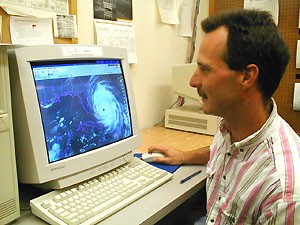Hurricane Floyd not as threatening for Northeast as Agnes in 1972, but still with potential to 'create some havoc,' Cornell climatologist says
By Blaine Friedlander
Despite the immensity of Hurricane Floyd, which after sweeping over Florida is bearing down on the Carolinas and threatening the U.S. eastern seaboard, climatologists at the Northeast Regional Climate Center at Cornell University believe the storm will not pack the watery wallop of hurricane-turned-tropical storm Agnes in 1972.
"If Floyd comes this way as forecasted, the rainfall amounts won't be as high," says Keith Eggleston, senior climatologist at the center. "Agnes moved slowly and it rained over several days. Floyd, on the other hand, is expected to move through the northeast more quickly so the storm won't have as much time to drop as much rain. But this is really speculation right now as the track of Floyd is so uncertain."
Eggleston, though, doesn't downplay the power of Floyd, which he says has the potential to create some havoc in the Northeast. "While still not breaking records, it could have serious consequences. In other words, while it may not have record-breaking rain, there is the possibility of very heavy rain."
Eggleston says that when Agnes slammed into the area, the ground in the Northeast was already saturated with water. "Now, after a dry summer, the ground will be able to absorb more of the rain. If it is an intense rain, then there will be runoff and there could be some problems — possibly flash flooding."
Agnes formed over Mexico's Yucatan Peninsula on June 14, 1972, making landfall over the Florida panhandle as a Category 1 hurricane five days later. Hurricane Agnes was downgraded to a tropical depression as it took an inland path over Georgia, South Carolina and North Carolina. It moved off the North Carolina coast on June 21, 1972, and regained strength to become a tropical storm once again. Tropical storm Agnes moved inland again near Long Island on June 22, 1972, and moved northwest into upstate New York.
Thanks to Agnes' awesome power, June 1972 became the Northeast's wettest month on record, a record that stands today. The twelve-state region averaged 8.29 inches of precipitation -- more than twice the normal 3.86 inches for the month. It was also the wettest month on record for the states of New York (with 8.51 inches of rain versus a normal 3.84 inches) and Pennsylvania (with 11.23 inches versus a normal 4.23 inches.)
Precipitation for the period June 20-25, 1972, averaged about 7 inches across Maryland, Pennsylvania and parts of upstate New York. Some of the wettest reports for this six-day period included:
- York, Pa. 16.00 inches
- Harrisburg, Pa. 15.25 inches
- Lebanon, Pa. 14.08 inches
- Wellsville, N.Y. 14.00 inches
- Woodstock, Md. 13.99 inches
- Zerbey, Pa. 13.95 inches
- Westminster, Md. 13.77 inches
- Dulles Airport, Va. 13.70 inches
- Shamokin, Pa. 13.59 inches
- Williamsport, Pa. 13.50 inches
- Alfred, N.Y. 13.24 inches
Eggleston says most of the damage in the Northeast attributed to Agnes was the result of flooding. Winds associated with the storm were not excessive. In Maryland, there were 19 deaths and over $80 million in damages. The National Weather Service said Agnes would probably rank as the state's greatest natural disaster.
In New York, 24 lives were lost and damage totaled more than $280 million. More than 100,000 people were evacuated from their homes in what was termed the worst flood in the history of New York state. Approximately 17,000 homes were damaged or destroyed, the majority in the Elmira and Corning areas.
There were 50 storm-related deaths in Pennsylvania and about $2 billion in damage, forcing President Richard M. Nixon to declare the state a disaster area. More than 250,000 people had to be evacuated from their homes.
Media Contact
Get Cornell news delivered right to your inbox.
Subscribe